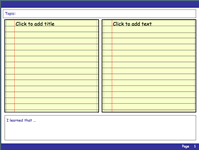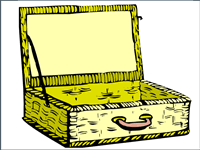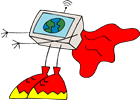 Information: Primary Sources
Information: Primary Sources
Primary sources can be exciting resources for learning when students are able to make personal connections to the contents of these materials. The key is building meaningful applications. Seek out photographs and other materials that contain the experiences of children.
Think about all the ways you can bring history alive through primary source documents. Students need to be able to analyze historical documents. Start with Explore and adapt the analysis worksheets from NARA (NARA Worksheets (PDF files): Artifact, Cartoon, Document, Map, Photograph, Poster, Sound). Create an Analysis Worksheet for your grade level. Then, create your own PowerPoint-based tool. If you need ideas, use the web evaluation project for inspiration.
Think about ways that learners could use bubbles for identifying parts of primary documents. Search the National Archives for particular treaties, papers, and other well-known documents. Also, search Marcopolo/Thinkfinity for a particular document and you'll find lesson ideas and links to primary sources.
Go to Kids-Learn Elementary and Middle School for ideas on document-based questions.
History Starter
 Many social studies standards ask students to compare sources, documents, or perspectives. Use tools such as Inspiration or PowerPoint starters to provide space for students to make comparisons and draw conclusions. For example, ask students to compare two historical documents, letters, diary entries, or other original documents.
Many social studies standards ask students to compare sources, documents, or perspectives. Use tools such as Inspiration or PowerPoint starters to provide space for students to make comparisons and draw conclusions. For example, ask students to compare two historical documents, letters, diary entries, or other original documents.
Download and explore the Sources (PPT). This project contains two columns for student to write and make comparisons about an historical event or topic.
What They Carried
Let's use the example of the topic - What They Carried. This topic could be applied throughout history whether talking about what people carried on the Trail of Tears or the Oregon Trail.
 Connect to your personal possessions. What do you carry on a trip? Why? What would you save in a disaster? What would you leave behind in a time of war? Think about all the situations where people carry things through history:
Connect to your personal possessions. What do you carry on a trip? Why? What would you save in a disaster? What would you leave behind in a time of war? Think about all the situations where people carry things through history:
- On the ship
- On the wagon
- On the train
- To the camp
- Walking
Download and explore What They Carried Starter: Backpacks and Suitcases (PPT) and Carts (PPT). Select one of the backpacks, suitcases, or carts to use as the basis for a 1-3 slide student activity. Use the Hoursehold Objects section of the Historical website for historical artifacts.
Variations
- Examine the Leaving Things Behind from the Smithsonian PDF for ideas.
- Using the ideas and resources on this page, design your own assignment. Create a template in PowerPoint that students could use to get started. Copy one of graphics (i.e, backpack, suitcase, cart) into a new PowerPoint document. Locate graphics that represent objects that might be carried. Put them in the area surrounding the slide. Use the SpeakerNotes for the students assignment. For young children, use audio directions. For example, put things into the wagon that you could take on the Oregon Trail. Write about what you chose using the Speakernotes.
- Grades PreK-2
- Categorize items from the past vs present (i.e, transportation; candles or lights; toys; clothing)
- Identify and order events that take place in a sequence using photographs, drawings, or paintings such as photos from the school year, historical events (i.e., ancient times, exploration, colonial days, pioneers).
- Order photographs and tell about how times have changed (i.e, Native americans).
- Categorize photos of people in school (i.e., principal, nurse, custodian, secretary, school librarian) vs community (firefighters, mayor, police officer, store clerk)
- Categorize city and farm photos. What are the differences and similarities?
- Match community jobs and tools/clothing/environments.
- Use photos to tell about "a day in the life" of a person from another time period or culture.
- Categorize items from the past vs present (i.e, transportation; candles or lights; toys; clothing)
- Grades 3-5
- Compare pioneer and contemporary state famous people and how their lives are alike and different. How are the lives of politicans, business people, entertainers, etc. similar and different?
- How have places changed over time? Compare photos and maps.
- Compare pioneer and contemporary state famous people and how their lives are alike and different. How are the lives of politicans, business people, entertainers, etc. similar and different?
Go to the Word, Picture, & Sounds page. Scroll down to the bottom of the page for lots of book ideas and online primary documents. Create your own PowerPoint Sidekick.

